
List of mammals of Belarus
Encyclopedia

Belarus
Belarus , officially the Republic of Belarus, is a landlocked country in Eastern Europe, bordered clockwise by Russia to the northeast, Ukraine to the south, Poland to the west, and Lithuania and Latvia to the northwest. Its capital is Minsk; other major cities include Brest, Grodno , Gomel ,...
, of which 0 are critically endangered, 2 are endangered, 4 are vulnerable, and 3 are near-threatened.
1 of the species listed for Belarus can no longer be found in the wild.
The following tags are used to highlight each species' conservation status as assessed by the IUCN
World Conservation Union
The International Union for Conservation of Nature and Natural Resources is an international organization dedicated to finding "pragmatic solutions to our most pressing environment and development challenges." The organization publishes the IUCN Red List, compiling information from a network of...
:
| EX | Extinct | No reasonable doubt that the last individual has died. |
| EW | Extinct in the wild | Known only to survive in captivity or as a naturalized populations well outside its previous range. |
| CR | Critically Endangered | The species is in imminent risk of extinction in the wild. |
| EN | Endangered | The species is facing an extremely high risk of extinction in the wild. |
| VU | Vulnerable | The species is facing a high risk of extinction in the wild. |
| NT | Near Threatened | The species does not meet any of the criteria that would categorise it as risking extinction but it is likely to do so in the future. |
| LC | Least Concern | There are no current identifiable risks to the species. |
| DD | Data Deficient | There is inadequate information to make an assessment of the risks to this species. |
Some species were assessed using an earlier set of criteria. Species assessed using this system have the following instead of Near Threatened and Least Concern categories:
| LR/cd | Lower Risk/conservation dependent | Species which were the focus of conservation programmes and may have moved into a higher risk category if that programme was discontinued. |
| LR/nt | Lower Risk/near threatened | Species which are close to being classified as Vulnerable but are not the subject of conservation programmes. |
| LR/lc | Lower Risk/least concern | Species for which there are no identifiable risks. |
Order: RodentRodentRodentia is an order of mammals also known as rodents, characterised by two continuously growing incisors in the upper and lower jaws which must be kept short by gnawing....
ia (rodents)
----
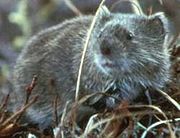

Incisor
Incisors are the first kind of tooth in heterodont mammals. They are located in the premaxilla above and mandible below.-Function:...
s in the upper and lower jaw which grow continually and must be kept short by gnawing. Most rodents are small though the capybara
Capybara
The capybara , also known as capivara in Portuguese, and capibara, chigüire in Venezuela, Colombia, and Ecuador ronsoco in Peru, chigüiro, and carpincho in Spanish, is the largest living rodent in the world. Its closest relatives are agouti, chinchillas, coyphillas, and guinea pigs...
can weigh up to 45 kg (100 lb).
- Suborder: SciurognathiSciurognathiSciurognathi is a suborder of rodents that includes squirrels, chipmunks, beavers, and many types of mice. The group is characterized by a specific shape to the lower jaw. In sciurognaths, the angular process of the jaw is in the same plane as the root of the incisors...
- Family: CastoridaeCastoridaeThe family Castoridae contains the two living species of beaver and their fossil relatives. This was once a highly diverse group of rodents, but is now restricted to a single genus, Castor.- Characteristics :...
(beavers)-
- Genus: Castor
- European BeaverEuropean BeaverThe Eurasian beaver or European beaver is a species of beaver, which was once widespread in Eurasia, where it was hunted to near extinction both for fur and for castoreum, a secretion of its scent gland believed to have medicinal properties...
Castor fiber NT
- European Beaver
- Genus: Castor
-
- Family: Sciuridae (squirrels)
- Subfamily: SciurinaeSciurinaeThe Sciurinae is a subfamily of squirrels in the . It unites the flying squirrels with certain related tree squirrels. Older sources place the flying squirrels in a separate subfamily and unite all remaining sciurids into the subfamily Sciurinae, but this has been strongly refuted by genetic...
- Tribe: Pteromyini
- Genus: Pteromys
- Siberian Flying SquirrelSiberian Flying SquirrelThe Siberian Flying Squirrel is an Old World flying squirrel with a range from the Baltic Sea in the west to the Pacific coast in the east. It is the only species of flying squirrel found in Europe...
Pteromys volans LR/nt
- Siberian Flying Squirrel
- Genus: Pteromys
- Tribe: Pteromyini
- Subfamily: XerinaeXerinaeXerinae is a subfamily of squirrels, many of which are highly terrestrial. It includes the tribes Marmotini , Xerini , and Protoxerini .-References:* Thorington, R. W. and R. S. Hoffmann. 2005. Family Sciuridae. Pp 754-818 in Wilson, E. D...
- Tribe: Marmotini
- Genus: Marmota
- Bobak MarmotBobak MarmotThe bobak marmot , also known as the steppe marmot, is a species of marmot that inhabits the steppes of Eastern Europe and Central Asia. It is also found in Belarus...
Marmota bobak LR/cd
- Bobak Marmot
- Genus: Marmota
- Tribe: Marmotini
- Subfamily: Sciurinae
- Family: Gliridae (dormice)
- Subfamily: LeithiinaeLeithiinaeLeithiinae is a subfamily of dormice.-Classification:Subfamily Leithiinae*Genus Chaetocauda**Chinese Dormouse, Chaetocauda sichuanensis*Genus Dryomys**Woolly Dormouse, Dryomys laniger...
- Genus: Dryomys
- Forest dormouseForest dormouseDryomys is a genus of dormouse found throughout much of Eurasia, known collectively as the forest dormice. They generally occur in forests or thickets.Head and body is , and tail length is . The animals weigh .- Natural history :...
Dryomys nitedula LR/nt
- Forest dormouse
- Genus: Muscardinus
- Hazel DormouseHazel DormouseThe Hazel Dormouse or Common Dormouse is a small mammal and the only living species in the genus Muscardinus....
Muscardinus avellanarius LR/nt
- Hazel Dormouse
- Genus: Dryomys
- Subfamily: GlirinaeGlirinaeGlirinae is a subfamily of dormice .It contains two extant genera, each one having one species:Subfamily Glirinae*Genus Glirulus**Japanese Dormouse, Glirulus japonicus*Genus Glis**Edible Dormouse, Glis glis...
- Genus: Glis
- Edible dormouseEdible dormouseThe edible dormouse or fat dormouse is a large dormouse and the only living species in the genus Glis.-Description:...
Glis glis LR/nt
- Edible dormouse
- Genus: Glis
- Subfamily: Leithiinae
- Family: CricetidaeCricetidaeThe Cricetidae are a family of rodents in the large and complex superfamily Muroidea. It includes true hamsters, voles, lemmings, and New World rats and mice...
- Subfamily: ArvicolinaeArvicolinaeThe Arvicolinae are a subfamily of rodents that includes the voles, lemmings, and muskrats. They are most closely related to the other subfamilies in the Cricetidae . Some authorities place the subfamily Arvicolinae in the family Muridae along with all other members of the superfamily Muroidea...
- Genus: ArvicolaArvicolaThe water voles are large voles in the genus Arvicola. They are found in both aquatic and dry habitat through Europe and much of northern Asia...
- Water Vole Arvicola terrestris LR/lc
- Genus: Clethrionomys
- Bank VoleBank VoleThe bank vole is a small vole with red-brown fur and some grey patches, with a tail about half as long as its body. A rodent, it lives in woodland areas and is around in length. The bank vole is found in western Europe and northern Asia...
Clethrionomys glareolus LR/lc
- Bank Vole
- Genus: MicrotusMicrotusThe genus Microtus is a group of voles found in North America, Europe and northern Asia. The genus name refers to the small ears of these animals. There are 62 species in the genus....
- Field VoleField VoleThe field vole or short-tailed vole, Microtus agrestis, is a grey-brown vole, around 110mm in length, with only a short tail. They are one of the most common mammals in Europe, ranging from the Atlantic coast to Lake Baikal. They are found in moist grassy habitats, such as woodland, marsh, or...
Microtus agrestis LR/lc - Common VoleCommon VoleThe Common Vole, Microtus arvalis, is a European mammal.- Distribution and habitat :The common vole is hardly restricted in means of distribution and habitat and inhabits large areas of Eurasia. As Microtus arvalis followed human civilisation, primary and secondary habitats can be distinguished...
Microtus arvalis LR/lc - Tundra VoleTundra VoleThe Tundra Vole or Root Vole, Microtus oeconomus, is a medium-sized vole found in Northern and Central Europe, Asia, and northwestern North America, including Alaska and northwestern Canada...
Microtus oeconomus LC
- Field Vole
- Genus: Arvicola
- Subfamily: Arvicolinae
- Family: MuridaeMuridaeMuridae is the largest family of mammals. It contains over 600 species found naturally throughout Eurasia, Africa, and Australia. They have been introduced worldwide. The group includes true mice and rats, gerbils, and relatives....
(mice, rats, voles, gerbils, hamsters, etc.)- Subfamily: MurinaeMurinaeThe Old World rats and mice, part of the subfamily Murinae in the family Muridae, comprise at least 519 species. This subfamily is larger than all mammal families except the Cricetidae and Muridae, and is larger than all mammal orders except the bats and the remainder of the...
- Genus: ApodemusApodemusApodemus is the genus of Muridae which contains the Eurasian field mice. Related to the Ryūkyū spiny rats and the prehistoric Rhagamys – and far more distantly to Mus and Malacomys –, it includes the following species:*Striped Field Mouse, Apodemus agrarius*Alpine Field Mouse, Apodemus...
- Striped Field MouseStriped Field MouseThe Striped Field Mouse is a rodent in the family Muridae. The range of this species stretches from Eastern Europe to Japan, including Taiwan and Siberia....
Apodemus agrarius LR/lc - Yellow-necked MouseYellow-necked mouseThe Yellow-necked Mouse Apodemus flavicollis is closely related to the wood mouse, with which it was long confused, only being recognised as a separate species in 1894. It differs in its band of yellow fur around the neck and in having slightly larger ears and usually being slightly larger overall....
Apodemus flavicollis LR/lc - Wood mouseWood mouseThe wood mouse is a common murid rodent from Europe and northwestern Africa. It is closely related to the yellow-necked mouse but differs in that it has no band of yellow fur around the neck, has slightly smaller ears, and is usually slightly smaller overall: around 90 mm in length...
Apodemus sylvaticus LC - Ural Field MouseUral Field MouseThe Ural Field Mouse is a species of rodent in the family Muridae. It is also known as the Pygmy Field Mouse. It is found in Armenia, Austria, Azerbaijan, Belarus, Bulgaria, China, Croatia, Czech Republic, Estonia, Georgia, Hungary, Kazakhstan, Latvia, Liechtenstein, Lithuania, Mongolia,...
Apodemus uralensis LR/lc
- Striped Field Mouse
- Genus: MicromysMicromysMicromys is a genus of small rodents in the subfamily Murinae without close relations to any other murine genus. It contains two living species: the widespread Eurasian harvest mouse of much of Europe and Asia and the more restricted Micromys erythrotis of Vietnam, southern China, and perhaps...
- Harvest Mouse Micromys minutus LR/nt
- Genus: Apodemus
- Subfamily: Murinae
- Family: Castoridae
Order: LagomorphaLagomorphaThe lagomorphs are the members of the taxonomic order Lagomorpha, of which there are two living families, the Leporidae , and the Ochotonidae...
(lagomorphs)
----
Leporidae
Leporids are the approximately 50 species of rabbits and hares which form the family Leporidae. The leporids, together with the pikas, constitute the mammalian order Lagomorpha. Leporids differ from pikas in having short furry tails, and elongated ears and hind legs...
(hare
Hare
Hares and jackrabbits are leporids belonging to the genus Lepus. Hares less than one year old are called leverets. Four species commonly known as types of hare are classified outside of Lepus: the hispid hare , and three species known as red rock hares .Hares are very fast-moving...
s and rabbit
Rabbit
Rabbits are small mammals in the family Leporidae of the order Lagomorpha, found in several parts of the world...
s), and Ochotonidae (pika
Pika
The pika is a small mammal, with short limbs, rounded ears, and short tail. The name pika is used for any member of the Ochotonidae, a family within the order of lagomorphs, which also includes the Leporidae . One genus, Ochotona, is recognised within the family, and it includes 30 species...
s). Though they can resemble rodent
Rodent
Rodentia is an order of mammals also known as rodents, characterised by two continuously growing incisors in the upper and lower jaws which must be kept short by gnawing....
s, and were classified as a superfamily
Taxonomic rank
In biological classification, rank is the level in a taxonomic hierarchy. Examples of taxonomic ranks are species, genus, family, and class. Each rank subsumes under it a number of less general categories...
in that order until the early twentieth century, they have since been considered a separate order. They differ from rodents in a number of physical characteristics, such as having four incisors in the upper jaw rather than two.
- Family: LeporidaeLeporidaeLeporids are the approximately 50 species of rabbits and hares which form the family Leporidae. The leporids, together with the pikas, constitute the mammalian order Lagomorpha. Leporids differ from pikas in having short furry tails, and elongated ears and hind legs...
(rabbits, hares)- Genus: LepusHareHares and jackrabbits are leporids belonging to the genus Lepus. Hares less than one year old are called leverets. Four species commonly known as types of hare are classified outside of Lepus: the hispid hare , and three species known as red rock hares .Hares are very fast-moving...
- European HareEuropean HareThe European hare , also known as the brown hare, Eastern Jackrabbit and Eastern prairie hare, is a species of hare native to northern, central, and western Europe and western Asia. It is a mammal adapted to temperate open country. It is related to the similarly appearing rabbit, which is in the...
Lepus europaeus LR/lc - Mountain HareMountain HareThe Mountain Hare , also known as Blue Hare, Tundra Hare, Variable Hare, White Hare, Alpine Hare and Irish Hare, is a hare, which is largely adapted to polar and mountainous habitats. It is distributed from Fennoscandia to eastern Siberia; in addition there are isolated populations in the Alps,...
Lepus timidus LR/lc
- European Hare
- Genus: Lepus
Order: Erinaceomorpha (hedgehogs and gymnures)
----The order Erinaceomorpha contains a single family, Erinaceidae, which comprise the hedgehog
Hedgehog
A hedgehog is any of the spiny mammals of the subfamily Erinaceinae and the order Erinaceomorpha. There are 17 species of hedgehog in five genera, found through parts of Europe, Asia, Africa, and New Zealand . There are no hedgehogs native to Australia, and no living species native to the Americas...
s and gymnure
Gymnure
The gymnure, also called a hairy hedgehog or moonrat, is a type of mammal belonging to the subfamily Galericinae, in the family Erinaceidae and the order Erinaceomorpha...
s. The hedgehogs are easily recognised by their spines while gymnures look more like large rats.
- Family: ErinaceidaeErinaceidaeErinaceidae is the only living family in the order Erinaceomorpha, which has recently been subsumed with Soricomorpha into the order Eulipotyphla...
(hedgehogs)- Subfamily: Erinaceinae
- Genus: ErinaceusErinaceusErinaceus is a genus of European hedgehog from the family of Erinaceidae. There are four main species of Erinaceus. The range is all across Europe, throughout the Middle East, parts of Russia, and extending to northern China...
- Southern White-breasted Hedgehog Erinaceus concolor LR/lc
- Genus: Erinaceus
- Subfamily: Erinaceinae
Order: SoricomorphaSoricomorphaThe order Soricomorpha is taxon within the class of mammals. In previous years it formed a significant group within the former order Insectivora...
(shrews, moles, and soledons)
----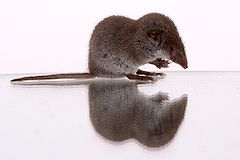
- Family: Soricidae (shrews)
- Subfamily: Crocidurinae
- Genus: CrociduraCrociduraThe genus Crocidura is one of nine genus of the shrew subfamily Crocidurinae. Members of the genus are commonly called white-toothed shrews or musk shrews, although both also apply to all of the species in the subfamily. With 182 species, Crocidura contains the largest number of species of any...
- Lesser White-toothed ShrewLesser white-toothed shrewThe Lesser White-toothed Shrew is a tiny shrew with a widespread distribution in Africa, Asia and Europe, but not in most of Spain, north–west France and mainland Great Britain. Its preferred habitat is scrub and gardens and it feeds on insects, worms, slugs, snails and small mice...
Crocidura suaveolens LR/lc
- Lesser White-toothed Shrew
- Genus: Crocidura
- Subfamily: Soricinae
- Tribe: NectogaliniNectogaliniNectogalini is a tribe of Old World water shrews within the family Soricidae. As of late 2007, it consisted of six extant genera and 25 species, with some of the latter being further divided into subspecies.-Adaptation to semi-aquatic life:...
- Genus: NeomysNeomysThe genus Neomys is a group of three Eurasian water shrews from the subfamily Soricinae of the family Soricidae. These shrews are found in most of Europe, and parts of Northern Asia as well as Turkey and Iran...
- Eurasian Water ShrewEurasian Water ShrewThe Eurasian Water Shrew, Neomys fodiens, known in the United Kingdom as the Water Shrew, is a relatively large shrew, up to long, with a tail up to three-quarters as long again. It has short dark fur, often with a few white tufts, a white belly, and a few stiff hairs around the feet and tail...
Neomys fodiens LR/lc
- Eurasian Water Shrew
- Genus: Neomys
- Tribe: Soricini
- Genus: SorexSorexThe genus Sorex includes many of the common shrews of Eurasia and North America. Members of this genus, known as long-tailed shrews, are the only members of the tribe Soricini of the subfamily Soricinae...
- Laxmann's ShrewLaxmann's ShrewLaxmann's Shrew is a species of shrew. An adult Laxmann's Shrew has a weight of 3-11 grams and a body length of 4.8-7.8 cm, with a tail of 3.9-5.2 cm. It is reported across northern Eurasia from the Baltic to the Sea of Japan, including Hokkaidō, Sakhalin, and the Korean Peninsula...
Sorex caecutiens LR/lc - Eurasian Pygmy ShrewEurasian pygmy shrewThe Eurasian Pygmy Shrew , often known simply as the Pygmy Shrew, is a widespread shrew of northern Eurasia. It is the only shrew native to Ireland....
Sorex minutus LR/lc
- Laxmann's Shrew
- Genus: Sorex
- Tribe: Nectogalini
- Subfamily: Crocidurinae
- Family: TalpidaeTalpidaeThe family Talpidae includes the moles, shrew moles, desmans, and other intermediate forms of small insectivorous mammals of the order Soricomorpha...
(moles)- Subfamily: TalpinaeTalpinaeThe subfamily Talpinae, sometimes called "Old World moles" or "Old World moles and relatives", is one of three subfamilies of the mole family Talpidae, the others being the Scalopinae, or New World moles, and the Uropsilinae, or shrew-like moles....
- Tribe: Desmanini
- Genus: Desmana
- Russian DesmanRussian DesmanThe Russian Desman is a small semi-aquatic mammal that inhabits the Volga, Don and Ural River basins in Russia, Ukraine and Kazakhstan. It constructs burrows into the banks of ponds and slow-moving streams, but prefers small, overgrown ponds with abundance of insects, crayfish and amphibians...
Desmana moschata VU
- Russian Desman
- Genus: Desmana
- Tribe: Desmanini
- Subfamily: Talpinae
Order: Chiroptera (bats)
----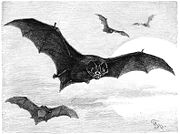
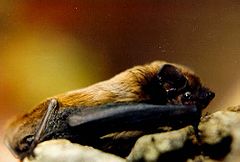
- Family: Vespertilionidae
- Subfamily: Myotinae
- Genus: Myotis
- Bechstein's BatBechstein's BatBechstein's Bat is a species of vesper bat in the Vespertilionidae family.It can be found in the following countries: Austria, Armenia, Belarus, Belgium, Bosnia and Herzegovina, Bulgaria, Croatia, Czech Republic, France, Georgia, Germany, Hungary, Iran, Italy, Liechtenstein, Republic of Macedonia,...
Myotis bechsteini VU - Pond BatPond BatThe Pond Bat is a species of vesper bat in the Vespertilionidae family. It is found in Eurasia from France to Russia and Kazakhstan.-Physical characteristics:...
Myotis dasycneme VU - Greater Mouse-eared BatGreater mouse-eared batThe greater mouse-eared bat, Myotis myotis, is a European species of bat in the Vespertilionidae family.-Description:It is relatively large for a member of the Myotis genus, weighing up to , making it one of the largest European bats.-Foraging:Like its relatives it eats various arthropods;...
Myotis myotis LR/nt - Natterer's batNatterer's batNatterer's bat is a European bat with pale wings. It has brown fur, also seen on the leg wing membrane, tending to white on its underside...
Myotis nattereri LR/lc
- Bechstein's Bat
- Genus: Myotis
- Subfamily: VespertilioninaeVespertilioninaeVespertilioninae is a subfamily of Vesper Bats from the family Vespertilionidae.-Classification:Subfamily Vespertilioninae*Tribe Eptesicini**Genus Arielulus***Collared Pipistrelle, Arielulus aureocollaris...
- Genus: BarbastellaBarbastellaBarbastella is a small genus of vespertilionid bats. There are three described species in this genus.-Species:Barbastella is a small genus of vespertilionid bats. There are three described species in this genus.-Species:...
- BarbastelleBarbastelleThe Barbastelle , also known as the Western Barbastelle, is a European bat. It has a short nose, small eyes and wide ears.It is rare throughout its range...
Barbastella barbastellus VU
- Barbastelle
- Genus: NyctalusNyctalusThe bat genus Nyctalus are members of the family Vespertilionidae or sometimes Evening bats. They are distributed in the temperate and subtropical areas of Europe, Asia and North Africa.There are eight species within this genus:...
- Greater Noctule batGreater Noctule batThe Greater Noctule bat is a rare mammal found in Europe, West Asia, and North Africa. It is the largest and least studied bat in Europe with a wingspan of up to 46 centimeters and is one of the few bat species to feed on passerine birds. Greater Noctule bat is the only bat species to hunt birds...
Nyctalus lasiopterus LR/nt - Lesser NoctuleLesser NoctuleThe Lesser Noctule or Leisler's Bat is a species of bat belonging to the vesper bat family, Vespertilionidae.-Description:...
Nyctalus leisleri LR/nt
- Greater Noctule bat
- Genus: Barbastella
- Subfamily: Myotinae
Order: CarnivoraCarnivoraThe diverse order Carnivora |Latin]] carō "flesh", + vorāre "to devour") includes over 260 species of placental mammals. Its members are formally referred to as carnivorans, while the word "carnivore" can refer to any meat-eating animal...
(carnivorans)
----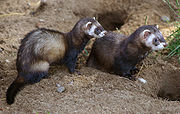
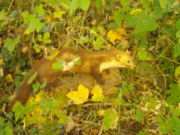
- Suborder: FeliformiaFeliformiaThe Feliformia are a suborder within the order Carnivora and includes cats , hyenas, mongooses, civets and related taxa. The other suborder of Carnivora is Caniformia...
- Family: FelidaeFelidaeFelidae is the biological family of the cats; a member of this family is called a felid. Felids are the strictest carnivores of the thirteen terrestrial families in the order Carnivora, although the three families of marine mammals comprising the superfamily pinnipedia are as carnivorous as the...
(cats)- Subfamily: FelinaeFelinaeFelinae is a subfamily of the family Felidae which includes the genera and species listed below. Most are small to medium-sized cats, although the group does include some larger animals, such as the Cougar and Cheetah....
- Genus: FelisFelisFelis is a genus of cats in the family Felidae, including the familiar domestic cat and its closest wild relatives. The wild species are distributed widely across Europe, southern and central Asia, and Africa; the domestic cat has been introduced worldwide.Members of the genus Felis are all small...
- WildcatWildcatWildcat is a small felid native to Europe, the western part of Asia, and Africa.-Animals:Wildcat may also refer to members of the genus Lynx:...
Felis silvestris LC
- Wildcat
- Genus: LynxLynxA lynx is any of the four Lynx genus species of medium-sized wildcats. The name "lynx" originated in Middle English via Latin from Greek word "λύγξ", derived from the Indo-European root "*leuk-", meaning "light, brightness", in reference to the luminescence of its reflective eyes...
- Eurasian LynxEurasian LynxThe Eurasian lynx is a medium-sized cat native to European and Siberian forests, South Asia and East Asia. It is also known as the European lynx, common lynx, the northern lynx, and the Siberian or Russian lynx...
Lynx lynx NT
- Eurasian Lynx
- Genus: Felis
- Subfamily: Felinae
- Family: Felidae
- Suborder: CaniformiaCaniformiaCaniformia, or Canoidea , is a suborder within the order Carnivora. They typically possess a long snout and non-retractile claws . The Pinnipedia evolved from caniform ancestors and are accordingly assigned to this group...
- Family: CanidaeCanidaeCanidae is the biological family of carnivorous and omnivorous mammals that includes wolves, foxes, jackals, coyotes, and domestic dogs. A member of this family is called a canid . The Canidae family is divided into two tribes: Canini and Vulpini...
(dogs, foxes)- Genus: CanisCanisCanis is a genus containing 7 to 10 extant species, including dogs, wolves, coyotes, and jackals, and many extinct species.-Wolves, dogs and dingos:Wolves, dogs and dingos are subspecies of Canis lupus...
- Gray WolfGray WolfThe gray wolf , also known as the wolf, is the largest extant wild member of the Canidae family...
Canis lupus LC
- Gray Wolf
- Genus: Canis
- Family: Ursidae (bears)
- Genus: UrsusUrsus (genus)Ursus is a genus in the family Ursidae that includes the widely distributed brown bears, the polar bear, and black bears. The name is derived from the Latin ursus, meaning bear.-Species and subspecies of Ursus:...
- Brown BearBrown BearThe brown bear is a large bear distributed across much of northern Eurasia and North America. It can weigh from and its largest subspecies, the Kodiak Bear, rivals the polar bear as the largest member of the bear family and as the largest land-based predator.There are several recognized...
Ursus arctos LR/lc
- Brown Bear
- Genus: Ursus
- Family: MustelidaeMustelidaeMustelidae , commonly referred to as the weasel family, are a family of carnivorous mammals. Mustelids are diverse and the largest family in the order Carnivora, at least partly because in the past it has been a catch-all category for many early or poorly differentiated taxa...
(mustelids)- Genus: Mustela
- StoatStoatThe stoat , also known as the ermine or short-tailed weasel, is a species of Mustelid native to Eurasia and North America, distinguished from the least weasel by its larger size and longer tail with a prominent black tip...
Mustela erminea LR/lc - Steppe PolecatSteppe polecatThe steppe polecat , also known as the white or masked polecat, is a species of Mustelid native to Central and Eastern Europe and Central Asia...
Mustela eversmannii LR/lc - European MinkEuropean minkThe European mink , also known as the Russian mink, is a semi-aquatic species of Mustelid native to Europe. It is listed by the IUCN as Endangered due to an ongoing reduction in numbers, having been calculated as being more than 50% over the past three generations...
Mustela lutreola EN - Least WeaselLeast WeaselThe least weasel is the smallest member of the Mustelidae , native to Eurasia, North America and North Africa, though it has been introduced elsewhere. It is classed as Least Concern by the IUCN, due to its wide distribution and presumably large population...
Mustela nivalis LR/lc - European PolecatEuropean polecatThe European polecat , also known as the black or forest polecat , is a species of Mustelid native to western Eurasia and North Africa, which is classed by the IUCN as Least Concern due to its wide range and large numbers. It is of a generally dark brown colour, with a pale underbelly and a dark...
Mustela putorius LR/lc
- Stoat
- Genus: Martes
- Beech MartenBeech MartenThe beech marten , also known as the stone marten or white breasted marten, is a species of marten native to much of Europe and Central Asia, though it has established a feral population in North America. It is listed as Least Concern by the IUCN on account of its wide distribution, its large...
Martes foina LR/lc
- Beech Marten
- Genus: MelesMeles (genus)Meles is a genus of badgers, containing three living species, the Japanese Badger , Asian Badger , and European Badger ....
- Eurasian BadgerEurasian BadgerThe European Badger is a species of badger of the genus Meles, native to almost all of Europe. It is classed as Least Concern for extinction by the IUCN, due to its wide distribution and large population....
Meles meles LR/lc
- Eurasian Badger
- Genus: LutraLutraLutra is a genus of otters.*Lutra nippon - Japanese otter*Lutra sumatrana - Hairy-nosed otter*Lutra lutra - European otter-Habitat:Lutra are semi-aquatic mammals and therefore need to be well-adapted to both water and land...
- European OtterEuropean OtterThe European Otter , also known as the Eurasian otter, Eurasian river otter, common otter and Old World otter, is a European and Asian member of the Lutrinae or otter subfamily, and is typical of freshwater otters....
Lutra lutra NT
- European Otter
- Genus: Mustela
- Family: Canidae
Order: Perissodactyla (odd-toed ungulates)
----
Grazing
Grazing generally describes a type of feeding, in which a herbivore feeds on plants , and also on other multicellular autotrophs...
mammals. They are usually large to very large, and have relatively simple stomachs and a large middle toe.
- Family: EquidaeEquidaeEquidae is the taxonomic family of horses and related animals, including the extant horses, donkeys, and zebras, and many other species known only from fossils. All extant species are in the genus Equus...
(horses etc.)- Genus: EquusEquus (genus)Equus is a genus of animals in the family Equidae that includes horses, donkeys, and zebras. Within Equidae, Equus is the only extant genus. Like Equidae more broadly, Equus has numerous extinct species known only from fossils. This article deals primarily with the extant species.The term equine...
- Wild horseWild HorseThe wild horse is a species of the genus Equus, which includes as subspecies the domesticated horse as well as the undomesticated Tarpan and Przewalski's Horse. The Tarpan became extinct in the 19th century, and Przewalski's Horse was saved from the brink of extinction and reintroduced...
Equus ferus EW
- Wild horse
- Genus: Equus
Order: Artiodactyla (even-toed ungulates)
----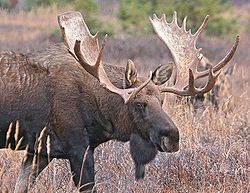
Ungulate
Ungulates are several groups of mammals, most of which use the tips of their toes, usually hoofed, to sustain their whole body weight while moving. They make up several orders of mammals, of which six to eight survive...
s whose weight is borne about equally by the third and fourth toes, rather than mostly or entirely by the third as in perissodactyls. There are about 220 artiodactyl species, including many that are of great economic importance to humans.
- Family: SuidaeSuidaeSuidae is the biological family to which pigs belong. In addition to numerous fossil species, up to sixteen extant species are currently recognized, classified into between four and eight genera...
(pigs)- Subfamily: SuinaeSuinaeSuinae is a subfamily of mammals that includes at least some of the living members of the family Suidae and their closest relatives—the domestic pig and related species, such as babirusas. Several extinct species within Suidae are classified in subfamilies other than Suinae...
- Genus: Sus
- BoarBoarWild boar, also wild pig, is a species of the pig genus Sus, part of the biological family Suidae. The species includes many subspecies. It is the wild ancestor of the domestic pig, an animal with which it freely hybridises...
Sus scrofa LR/lc
- Boar
- Genus: Sus
- Subfamily: Suinae
- Family: Cervidae (deer)
- Subfamily: CervinaeCervinaeCervinae or the Old World deer , is a subfamily of deer. Alternatively, they're known as the Plesiometacarpal deer, due to their ankle structure being different from the Telemetecarpal deer of Capreolinae-Classification and Species:The list is based on the studies of Randi, Mucci, Claro-Hergueta,...
- Genus: CervusCervusCervus is a genus of deer that primarily are native to Eurasia, although one species occurs in northern Africa and another in North America. In addition to the species presently placed in this genus, it has included a whole range of other species now commonly placed in other genera, but some of...
- Red DeerRed DeerThe red deer is one of the largest deer species. Depending on taxonomy, the red deer inhabits most of Europe, the Caucasus Mountains region, Asia Minor, parts of western Asia, and central Asia. It also inhabits the Atlas Mountains region between Morocco and Tunisia in northwestern Africa, being...
Cervus elaphus LR/lc
- Red Deer
- Genus: Cervus
- Subfamily: CapreolinaeCapreolinaeCapreolinae, also known as Odocoileinae or the New World deer , is a subfamily of deer...
- Genus: Alces
- MooseMooseThe moose or Eurasian elk is the largest extant species in the deer family. Moose are distinguished by the palmate antlers of the males; other members of the family have antlers with a dendritic configuration...
Alces alces LR/lc
- Moose
- Genus: Alces
- Subfamily: Cervinae
- Family: Bovidae (cattle, antelope, sheep, goats)
- Subfamily: BovinaeBovinaeThe biological subfamily Bovinae includes a diverse group of 10 genera of medium to large sized ungulates, including domestic cattle, the bison, African buffalo, the water buffalo, the yak, and the four-horned and spiral-horned antelopes...
- Genus: BisonBisonMembers of the genus Bison are large, even-toed ungulates within the subfamily Bovinae. Two extant and four extinct species are recognized...
- WisentWisentThe wisent , Bison bonasus, also known as the European bison or European wood bison, is a species of Eurasian bison. It is the heaviest surviving land animal in Europe; a typical wisent is about long, not counting a tail of long, and tall. Weight typically can range from , with an occasional big...
Bison bonasus EN
- Wisent
- Genus: Bison
- Subfamily: Bovinae
See also
- List of chordate orders
- List of regional mammals lists
- List of prehistoric mammals
- Mammal classificationMammal classificationMammalia is a class of animal within the Phylum Chordata. Mammal classification has been through several iterations since Carolus Linnaeus initially defined the class. Many earlier ideas have been completely abandoned by modern taxonomists, among these are the idea that bats are related to birds...
- New mammal species

